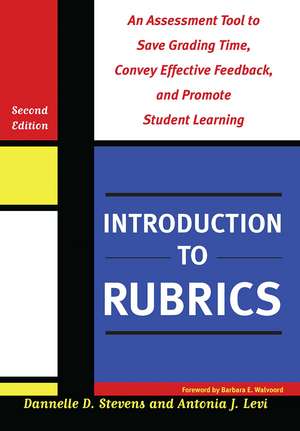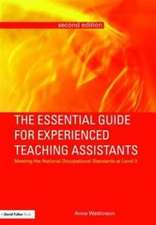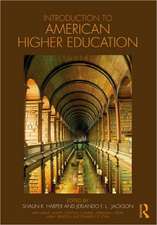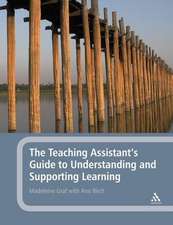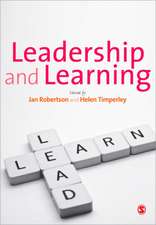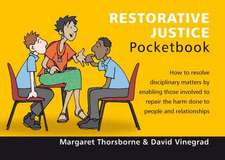Introduction to Rubrics: An Assessment Tool to Save Grading Time, Convey Effective Feedback, and Promote Student Learning
Autor Dannelle D. Stevens, Antonia J. Levien Limba Engleză Paperback – 16 oct 2012
| Toate formatele și edițiile | Preț | Express |
|---|---|---|
| Paperback (1) | 263.08 lei 6-8 săpt. | |
| Taylor & Francis – 16 oct 2012 | 263.08 lei 6-8 săpt. | |
| Hardback (1) | 1004.55 lei 6-8 săpt. | |
| Taylor & Francis – 8 oct 2012 | 1004.55 lei 6-8 săpt. |
Preț: 263.08 lei
Nou
Puncte Express: 395
Preț estimativ în valută:
50.36€ • 54.72$ • 42.33£
50.36€ • 54.72$ • 42.33£
Carte tipărită la comandă
Livrare economică 21 aprilie-05 mai
Preluare comenzi: 021 569.72.76
Specificații
ISBN-13: 9781579225889
ISBN-10: 1579225888
Pagini: 238
Dimensiuni: 178 x 254 x 14 mm
Greutate: 0.42 kg
Ediția:2
Editura: Taylor & Francis
Colecția Routledge
Locul publicării:Oxford, United Kingdom
ISBN-10: 1579225888
Pagini: 238
Dimensiuni: 178 x 254 x 14 mm
Greutate: 0.42 kg
Ediția:2
Editura: Taylor & Francis
Colecția Routledge
Locul publicării:Oxford, United Kingdom
Public țintă
Postgraduate and Professional Practice & DevelopmentCuprins
LIST OF FIGURES FOREWORD Barbara E. Walvoord PREFACE TO THE SECOND EDITION PREFACE TO THE FIRST EDITION PART I. AN INTRODUCTION TO RUBRICS 1. WHAT IS A RUBRIC? 2. WHY USE RUBRICS? 3. HOW TO CONSTRUCT A RUBRIC PART II. RUBRIC CONSTRUCTION AND USE IN DIFFERENT CONTEXTS 4. RUBRIC CONSTRUCTION AND THE CLASSROOM 5. RUBRIC CONSTRUCTION WITH OTHERS. TEACHING ASSISTANTS, TUTORS, OR COLLEAGUES 6. GRADING WITH RUBRICS 7. MAKING IT YOURS 8. RUBRICS FOR LEARNING FROM EXPERIENCE 9. RUBRICS AND ONLINE LEARNING 10. RUBRICS AND TEACHING IMPROVEMENT 11. RUBRICS FOR SELF-ASSESSMENT AND CAREER ADVANCEMENT 12. RUBRICS AND PROGRAM ASSESSMENT EPILOGUE. THE RUBRICS MANIFESTO REFERENCES APPENDICES INDEX
Notă biografică
Dannelle D. Stevens is a tenured professor in the Department of Curriculum and Instruction at Portland State University in Oregon where she has been since 1994. Her roots, however, are in the public school classroom where she taught middle school and high school social studies, language arts, and special education for 14 years across four school districts and three states. She received her master's from the University of Utah in 1983, and a doctorate in educational psychology from Michigan State in 1991. Before coming to PSU she taught at Whitman College in Walla Walla, Washington. Whether the topic is rubrics, journal writing, action research or academic writing, her work centers on how adults reflect on what they do and, then, act on those reflections. One of Dr. Stevens' underlying assumptions is that cognitive, social and emotional development does not end with the teenage years but continues through the lifetime. Besides over 75 conference presentations, she has written three books, all designed to impact development of her fellow faculty and their students. Her first book, co-edited with Joanne Cooper, Tenure in the Sacred Grove: Issues and Strategies for Women and Minorities, (SUNY Press, 2002), was written to help faculty women and minorities negotiate the path to tenure. Introduction to Rubrics, now in its second edition, and co-authored with Antonia J. Levi, and Journal Keeping, co-authored with Joanne Cooper, are both published by Stylus Publishing. In addition to teaching classes, she has taken on leadership positions in the department and campus-wide. In the Curriculum and Instruction Department, Dr. Stevens leads teacher licensure cohorts and coordinates the MA/MS program for experienced teachers. For the university at large, she works within the Center for Academic Excellence as faculty-in-residence for assessment. She is chair of the Institutional Assessment Council.
Antonia J. Levi is a professor of Japanese history and popular culture who taught for many years in Portland (Oregon) State University's University Studies Program, an innovative common core experience for Freshmen that created and utilizes many of the methodologies found in Introduction to Rubrics. Now retired, she serves part-time as a mentor and curriculum developer in Simon Fraser University's South Bank Writer's Program in British Columbia (Canada) where she is working on expanding the use of rubrics for creative writers. She has over thirty years of active classroom experience, and has worked on numerous projects from creating portfolios for seamless transitions to increasing opportunities for overseas studies programs. Her experience with rubrics in the classroom has contributed to these programs as well.
Barbara E. Walvoord is a Professor Emerita at the University of Notre Dame, Indiana. She is the author of numerous books, including Effective Grading: A Tool for Learning and Assessment with V. J. Anderson, and Assessment Clear and Simple: A Practical Guide for Institutions, Departments, and General Education
Antonia J. Levi is a professor of Japanese history and popular culture who taught for many years in Portland (Oregon) State University's University Studies Program, an innovative common core experience for Freshmen that created and utilizes many of the methodologies found in Introduction to Rubrics. Now retired, she serves part-time as a mentor and curriculum developer in Simon Fraser University's South Bank Writer's Program in British Columbia (Canada) where she is working on expanding the use of rubrics for creative writers. She has over thirty years of active classroom experience, and has worked on numerous projects from creating portfolios for seamless transitions to increasing opportunities for overseas studies programs. Her experience with rubrics in the classroom has contributed to these programs as well.
Barbara E. Walvoord is a Professor Emerita at the University of Notre Dame, Indiana. She is the author of numerous books, including Effective Grading: A Tool for Learning and Assessment with V. J. Anderson, and Assessment Clear and Simple: A Practical Guide for Institutions, Departments, and General Education
Recenzii
“Anyone struggling with the new landscape of direct assessment of student learning demanded by accreditors and employers will find this new and expanded edition of Introduction to Rubrics to be exactly what they need. Based upon their extensive experience, and drawing on a wide variety of examples of rubric use by faculty across institutions and disciplines, the authors clearly and insightfully present the value of rubrics, the process of developing rubrics and using them, and their usefulness for faculty, and for improving student learning. A 'must' read for anyone seriously interested in student learning enhancement.”
Terrel Rhodes, Vice President for the Office of Quality, Curriculum and Assessment
Association of American Colleges and Universities
"Students consistently tell us that good teachers give them constant feedback and are clear about their expectations and agendas. One way to accomplish both these purposes is by using well-constructed rubrics.Introduction to Rubrics provides a wonderfully helpful guide to creating rubrics that provide timely and detailed feedback and encourage the development of critical thinking. For teachers seeking to improve how they communicate the essentials of learning to students it will be an invaluable resource"
Stephen D. Brookfield, Distinguished University Professor
University of St. Thomas
From the Foreword:
"A rubric, the authors emphasize, is a tool. And their book itself is a wonderful tool for exploring how to use rubrics as tools. For a long time, I have been recommending the first edition to faculty in workshops I lead. I can recommend this second edition with even greater enthusiasm, because it does so much more, and does it so intelligently.
The authors offer advice about all the surrounding situations and problems that may accompany rubrics: how to get students involved in rubrics, how to use rubrics with TAs, how to collaborate with other faculty in constructing common rubrics, and how to use rubrics that someone else has constructed. The book focuses on rubrics but offers a great deal of advice about good teaching, good collaboration, and good assessment. In short, this book is a great tool."
Barbara E. Walvoord, Professor Emerita
University of Notre Dame, and author of Effective Grading and Assessment Clear and Simple
"Rubrics often generate about as much enthusiasm as the department newsletter -- until you use them. Dannelle D. Stevens and Antonia J. Levi’s Introduction to Rubrics: An Assessment Tool to Save Grading Time, Convey Effective Feedback and Promote Student Learning (Stylus, 2012) will convince you to give them a try. The concept is simple: rather than having students guess what they need to do for a good paper, give them a simple, straightforward outline. Even better, have them participate in creating the rubric. Stevens and Levi argue persuasively that involving students in the generation of a rubric results in a greater sense of buy-in.
Rubrics are also especially helpful for three groups of students: first-generation college students, students who didn’t come from elite high schools and students who aren’t majoring in your field. In other words, the majority of your classroom can benefit from a clear, comprehensible statement of what makes for an A, C or F paper as far as sources, arguments, mechanics and the like. And of course, rubrics needn’t be limited to paper grading, but can be employed for a variety of other assignments or even participation grades. Other potential benefits include reducing grading time by avoiding writing the same thing dozens of times, as well as keeping a large teaching staff on the same page."
Inside Higher Ed
Acclaim for the first edition:
"Easy to read, delectable teaching and learning aids that can be adapted and employed with almost any post-secondary course, at any level...a handy resource with excellent potential for cultivating interdisciplinary relationships, and an aid that extends the location of education beyond the classroom.”
Teaching Theology & Religion
Acclaim for the first edition:
"Introduction to Rubrics by Stevens and Levi is a valuable tool for practitioners and researchers. This "how to" manual does an excellent job of focusing on the needs of its readers. Higher education faculty and administrators today understand the need to demonstrate the quality of the education they deliver. But at the same time, many also need help in discovering how to assess student learning efficiently and effectively This innovative resource on rubrics provides just that help... Introducation to Rubrics is an excellent resource not only for faculty development professionals, but also for all those who are truly interested in the field of student assessment, professional growth, and higher education accountability."
Community College Journal of Research and Practice
Acclaim for the first edition:
"Dannelle Stevens and Antonia Levi, do an outstanding job of defining rubrics and explaining how to create and use them in different contexts. The book is peppered with ancedotes drawn from their own teaching experiences, and the mechanistic aspects of rubric construction are presented in a straightforward, converstational style. Before describing rubric construction, the authors note that although it can be time consuming and intimidating at first, the process becomes easier with experience, particularly through adaptation of existing rubrics for other uses.... This book, which is enjoyable to read, serves as an essential resource for higher education faculty by highlighting the important role of rubrics and detailing the design and implementation process."
Journal of Food Science Education
Acclaim for the first edition:
"Introduction to Rubrics has two vital things in its favor. First, it is short, and second, it is packed with useful information. This book is an ideal resource for those who are just beginning to think about using rubrics. However, it is also very useful for those of us who already use rubrics but need to refine our applications or get new ideas about how to optimize their use. There are other resources on the Web that have many more rubric samples, such as Rubistar, but the strength of Stevens and Levi’s resource is that it is geared exclusively to college-level teaching, where a site such as Rubistar is not.”
Currents in Teaching and Learning
Acclaim for the first edition:
"Introduction to Rubrics offers an excellent guide to those student affairs professionals who have articulated clear intended learning and development outcomes and sought ways to measure the degree to which students are mastering those outcomes.”
Journal of College Student Development
Terrel Rhodes, Vice President for the Office of Quality, Curriculum and Assessment
Association of American Colleges and Universities
"Students consistently tell us that good teachers give them constant feedback and are clear about their expectations and agendas. One way to accomplish both these purposes is by using well-constructed rubrics.Introduction to Rubrics provides a wonderfully helpful guide to creating rubrics that provide timely and detailed feedback and encourage the development of critical thinking. For teachers seeking to improve how they communicate the essentials of learning to students it will be an invaluable resource"
Stephen D. Brookfield, Distinguished University Professor
University of St. Thomas
From the Foreword:
"A rubric, the authors emphasize, is a tool. And their book itself is a wonderful tool for exploring how to use rubrics as tools. For a long time, I have been recommending the first edition to faculty in workshops I lead. I can recommend this second edition with even greater enthusiasm, because it does so much more, and does it so intelligently.
The authors offer advice about all the surrounding situations and problems that may accompany rubrics: how to get students involved in rubrics, how to use rubrics with TAs, how to collaborate with other faculty in constructing common rubrics, and how to use rubrics that someone else has constructed. The book focuses on rubrics but offers a great deal of advice about good teaching, good collaboration, and good assessment. In short, this book is a great tool."
Barbara E. Walvoord, Professor Emerita
University of Notre Dame, and author of Effective Grading and Assessment Clear and Simple
"Rubrics often generate about as much enthusiasm as the department newsletter -- until you use them. Dannelle D. Stevens and Antonia J. Levi’s Introduction to Rubrics: An Assessment Tool to Save Grading Time, Convey Effective Feedback and Promote Student Learning (Stylus, 2012) will convince you to give them a try. The concept is simple: rather than having students guess what they need to do for a good paper, give them a simple, straightforward outline. Even better, have them participate in creating the rubric. Stevens and Levi argue persuasively that involving students in the generation of a rubric results in a greater sense of buy-in.
Rubrics are also especially helpful for three groups of students: first-generation college students, students who didn’t come from elite high schools and students who aren’t majoring in your field. In other words, the majority of your classroom can benefit from a clear, comprehensible statement of what makes for an A, C or F paper as far as sources, arguments, mechanics and the like. And of course, rubrics needn’t be limited to paper grading, but can be employed for a variety of other assignments or even participation grades. Other potential benefits include reducing grading time by avoiding writing the same thing dozens of times, as well as keeping a large teaching staff on the same page."
Inside Higher Ed
Acclaim for the first edition:
"Easy to read, delectable teaching and learning aids that can be adapted and employed with almost any post-secondary course, at any level...a handy resource with excellent potential for cultivating interdisciplinary relationships, and an aid that extends the location of education beyond the classroom.”
Teaching Theology & Religion
Acclaim for the first edition:
"Introduction to Rubrics by Stevens and Levi is a valuable tool for practitioners and researchers. This "how to" manual does an excellent job of focusing on the needs of its readers. Higher education faculty and administrators today understand the need to demonstrate the quality of the education they deliver. But at the same time, many also need help in discovering how to assess student learning efficiently and effectively This innovative resource on rubrics provides just that help... Introducation to Rubrics is an excellent resource not only for faculty development professionals, but also for all those who are truly interested in the field of student assessment, professional growth, and higher education accountability."
Community College Journal of Research and Practice
Acclaim for the first edition:
"Dannelle Stevens and Antonia Levi, do an outstanding job of defining rubrics and explaining how to create and use them in different contexts. The book is peppered with ancedotes drawn from their own teaching experiences, and the mechanistic aspects of rubric construction are presented in a straightforward, converstational style. Before describing rubric construction, the authors note that although it can be time consuming and intimidating at first, the process becomes easier with experience, particularly through adaptation of existing rubrics for other uses.... This book, which is enjoyable to read, serves as an essential resource for higher education faculty by highlighting the important role of rubrics and detailing the design and implementation process."
Journal of Food Science Education
Acclaim for the first edition:
"Introduction to Rubrics has two vital things in its favor. First, it is short, and second, it is packed with useful information. This book is an ideal resource for those who are just beginning to think about using rubrics. However, it is also very useful for those of us who already use rubrics but need to refine our applications or get new ideas about how to optimize their use. There are other resources on the Web that have many more rubric samples, such as Rubistar, but the strength of Stevens and Levi’s resource is that it is geared exclusively to college-level teaching, where a site such as Rubistar is not.”
Currents in Teaching and Learning
Acclaim for the first edition:
"Introduction to Rubrics offers an excellent guide to those student affairs professionals who have articulated clear intended learning and development outcomes and sought ways to measure the degree to which students are mastering those outcomes.”
Journal of College Student Development
Descriere
This new edition retains the appeal, clarity and practicality that made the first so successful, and continues to provide a fundamental introduction to the principles and purposes of rubrics, with guidance on how to construct them, use them to align course content to learning outcomes.
